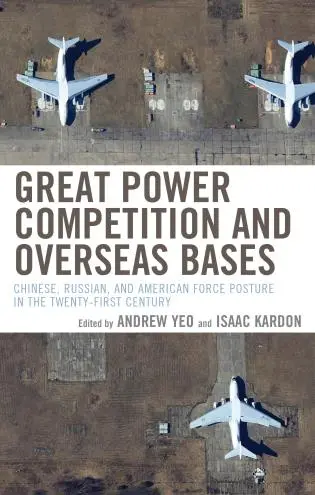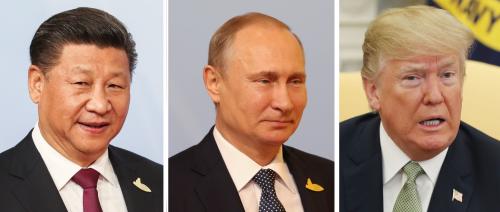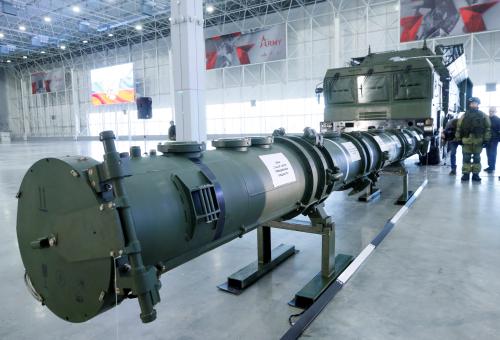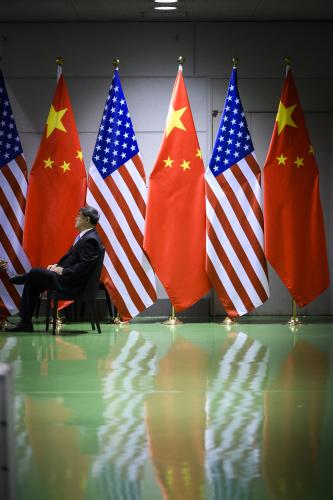On August 2, 2019, the United States formally withdrew from the Intermediate Nuclear Forces (INF) Treaty. It occurred in response to a Russian violation: the illegal deployment of a ground-launched cruise missile, the 9M792. However, Russia’s violation was not the only factor for Washington. As a non-signatory to the INF Treaty, China’s major build-up of its regional ballistic and cruise missile force has seriously eroded the U.S. conventional military advantage in East Asia.
In response to the threat posed by China’s missile force, some experts have proposed that the United States and its allies deploy ground-launched ballistic and cruise missiles of their own as a way to re-establish a more favorable conventional military balance in the region. There are significant military benefits to such a proposal: Ground-based systems are highly survivable, cost effective, and would help increase magazine capacity.
But the political challenges associated with deploying ground-launched missile systems in democratic states are significant. A more effective strategy would be for the United States and its allies to: 1) improve their air- and sea-based cruise missile capabilities in the region; 2) advance pragmatic arms control and risk reduction measures aimed at enhancing dialogue and limiting Chinese missile capabilities; and 3) enhance the resiliency of their critical infrastructure, especially space and cyber systems.
China’s march
Over the past decade, China has significantly improved its military capabilities, especially those designed to prevent potential adversaries from projecting power into the region. As Lieutenant General Robert Ashley, director of the Defense Intelligence Agency (DIA), testified to Congress in 2018:
Chinese military forces continue to develop capabilities to dissuade, deter, or defeat potential third-party intervention during a large-scale theater campaign, such as a Taiwan contingency. China’s military modernization plan includes the development of capabilities to conduct long-range attacks against adversary forces that might deploy or operate in the western Pacific Ocean.
At the heart of this military modernization program is China’s large and growing force of conventionally-armed short-, medium-, and intermediate-range ballistic and cruise missiles. According to a recent DIA report on Chinese military power: “The PRC has more than 1,250 ground-launched ballistic missiles (GLBMs) and ground-launched cruise missiles (GLCMs) with ranges between 500 and 5,500 kilometers.” This assessment is consistent with similar research published by independent experts.
China has supplemented its conventional missile force with a number of other weapons designed to make it increasingly difficult for the United States to project military power in East Asia. It is improving its integrated air defense systems to deny the U.S. the ability to penetrate Chinese airspace. A recent report by the Royal United Services Institute on Chinese and Russian air defense capability states that “the ability for the U.S. and its allies to project airpower within 1,000 kilometers of China’s mainland shore in a conflict will shrink dramatically on current trends through the 2020s.”
China is also using outer space for national security purposes. For example, it has deployed satellites in orbit to track and target U.S. aircraft carriers with advanced missiles like the DF-21. And it is developing and deploying a full spectrum of anti-satellite weapons designed to degrade and destroy satellites, further complicating efforts by the United States to project power into the region. As a result of these and other advances, experts like retired U.S. Admiral James Stavridis argue that the military balance between the United States and China is “approximately equal in East Asia.” Therefore, one of the key strategic questions that has emerged is how might the United States and its allies re-establish a more favorable conventional military balance in the region?
Restoring balance, managing politics
In response to unfavorable military trends in East Asia and the demise of the INF Treaty, some experts have proposed that the U.S. and its allies consider deploying conventionally-armed, ground-based ballistic and cruise missile in the region.
Proponents make several arguments. First, deploying ground-launched systems would be less expensive to operate than air- and sea-based platforms. Second, air- and sea-based platforms perform multiple missions. For example, in addition to the offensive-strike mission, U.S. Aegis cruisers and destroyers are also required to conduct air defense, missile defense, and anti-submarine missions. Third, air- and sea-based platforms “have finite munitions magazine depth. As a result, the United States faces a regional ‘strike gap’ against Chinese land and sea targets.” And finally, mobile ballistic and cruise missiles are considered to be more survivable than air- and sea-based platforms. Indeed, I made a similar argument during congressional testimony in 2017, arguing that survivability concerns played a critical role in Russia’s decision to violate the INF Treaty by deploying the 9M792 ground-launched cruise missile.
Overall, the military arguments in support of deploying ground-based missiles in Asia are compelling, but deploying ground-based missiles in democratic countries, especially road-mobile systems, has always been politically challenging. Whereas leaders of authoritarian states like Russia, China, and North Korea can easily ignore public opinion, politicians in democratic states don’t have that luxury and must build public support for their decisions. This, in turn, can lead to significant delays in the deployment of military capabilities.
For example, in the United States in the 1970s and 1980s, there was a politically charged debate over the correct basing mode for the Peacekeeper (or MX) intercontinental ballistic missile. Additionally, the largescale protests in Western European nations in response to the North Atlantic Treaty Organization’s (NATO) move to deploy intermediate-range ballistic and cruise missiles came close to breaking the alliance.
Recent events in South Korea and Japan show this too. In 2015, the United States proposed deploying the Terminal High Altitude Area Defense (THAAD) missile defense system to South Korea to improve the ability to defeat North Korea’s short- and medium-range ballistic missiles. While the THAAD battery was ultimately deployed, the deployment created a strong domestic political backlash. This was further complicated by a Chinese diplomatic pressure campaign that sought to influence South Korean public opinion.
Japan’s June 2020 decision to cancel its planned deployment of two Aegis Ashore missile defense sites is another example of the political challenges land-based missile deployments face. Opposition from the local community, who expressed safety and environmental concerns about the sites, prompted the cancellation. As Japanese Defense Minister Taro Kono stated at a June 25, 2020, press conference: “We promised the local community we will control where the booster goes down, and we found out we were not able to do that. So, we couldn’t move ahead with this Aegis Ashore project.”
These episodes show that even when presented with a clear threat like North Korea’s ballistic missile force, building public support — even for defensive systems — to counter that threat can be a political challenging. A decision to deploy ground-based offensive systems would likely generate similar levels public opposition in allied countries. On top of that, China would likely launch aggressive diplomatic and information campaigns designed to complicate the domestic political situations in host nations.
Closing the gap
With sufficient political will, the U.S. and its allies could successfully deploy ground-launched missiles in the region. But does that political will exist? Regardless, the political costs would likely be high. At the same time, action must be taken to restore a more favorable conventional military balance in East Asia. Below are mix of near- and longer-term options that could help restore the balance, while minimizing the political risks. Some could be done relatively quickly, while others would take time.
- Improve allied air- and sea-based strike capabilities. In the near term, United States could work with allies in the region to improve their air- and sea-based strike capabilities. Indeed, Japanese Defense Minister Kono recently said that acquiring long-range strike capability was something Japan was considering, especially in light on the decision to cancel the two Aegis Ashore missile defense sites. Japan has a number of sea and air platforms that are capable of deploying land-attack missiles. For example, Japan’s Aegis destroyers are equipped with the MK41 Vertical Launching System that is capable of deploying the Tomahawk cruise missile. Additionally, Japan’s fleet of F-35 Lighting II fighters will have the capability to deploy the AGM-158B Joint Air-to-Surface Standoff Missile-Extended Range (JASSM-ER), “a long-range, conventional, air-to-ground, precision standoff missile.” Deployment of strike capabilities by Japan and other allies could complement U.S. systems, and enhance deterrence.
- Develop a conventional variant of the LRSO nuclear cruise missile. Over the longer-term, the U.S. could develop a conventional variant of the Long-Range Stand-Off (LRSO) nuclear cruise missile, which is currently under development. This new cruise missile, which is scheduled to become available in the 2030-timeframe, is being designed specifically to penetrate China’s sophisticated air defense capabilities. Deploying such a capability would significantly improve the ability of the United States to hold targets in China at risk.
- Explore SSGN replacement options. The U.S. Navy currently deploys four Ohio-class ballistic missile submarines (SSBNs) that have been reconfigured as guided missile submarines (SSGNs). These boats have the capability to deploy up to 154 Tomahawk cruise missiles and are highly survivable. All four SSGNs are scheduled to be retired by 2026. The Navy has not yet made a final decision on a replacement, though it is reported to be studying the possibility of purchasing a “large payload submarine” based on the Columbia-class SSBNs currently under development. Given the potential firepower it can bring to bear, and its survivability, the Department of Defense and Congress should seriously consider funding an SSGN replacement.
- Reconsider the Arsenal Ship concept. In the 1990s, the U.S. Navy and the Defense Advanced Research Projects Agency explored a concept to develop a new surface combatant ship known as the Arsenal Ship. According to one report: “The Navy envisioned that the ship would have a large capacity of different missiles, including Tomahawk and Standard, and space for future extended range gun systems.” Unfortunately, the program was cancelled in 1997. However, the strategic situation in the Western Pacific has changed fundamentally since the late 1990s, and an Arsenal Ship or similar concept could be a cost-effective way of helping close the conventional-strike gap in the region.
- Develop practical arms control and risk reduction measures with China. In addition to deploying military capabilities, the U.S. and its allies should also consider developing pragmatic arms control and risk reduction measures (e.g., stability talks, bilateral missile launch notification agreement, or a moratorium of further missile deployments) to reduce tensions with China. In April 2019, the Trump administration announced that it was seeking to bring China into a future nuclear arms control framework, focused on Chinese strategic nuclear weapons. But as I have written elsewhere, America’s primary military objective regarding China should be countering its efforts to gain conventional superiority in the Western Pacific. Instead of attempting to bring China into the U.S.-Russia strategic arms control framework, the U.S. would be better served by refocusing its near-term diplomatic efforts on trying to constrain the development of China’s asymmetric capabilities. This will not be easy, and China would likely demand limitations on U.S. and allied weapons systems (e.g., missile defense). That said, pragmatic diplomatic proposals and dialogue could help reduce tensions with China, as well as help solidify allied support for effective deterrence policies and programs.
- Enhance infrastructure resiliency. China’s conventionally-armed ballistic and cruise missiles are but one element on a broader anti-access, area denial (A2/AD) strategy designed to prevent the United States from projecting power into East Asia. Other elements of that strategy include the deployment of anti-satellite, offensive cyber, and electronic warfare capabilities. Given the vulnerabilities of these systems to attack, the United States and its allies should take steps in enhance it resiliency of its space, cyber, and other key assets so that they can better withstand attacks. One relatively easy step that could be taken in the near term would be to better disperse key assets in countries throughout the region.
Conclusion
China’s deployment of ballistic and cruise missiles has played a critical role in titling the conventional military balance of power in East Asia in its favor. A deployment of similar land-based capabilities by the United States and its allies could help counter this threat. But as recent events in Japan have shown, deploying land-based missiles in democratic countries is politically complicated. A better option would be for the United States to pursue a strategy that improved U.S. and allied air- and sea-based cruise missile capabilities; advanced pragmatic arms control and risk reduction measures with China; and enhanced the resiliency of its critical infrastructure. This would meet U.S. military and deterrence objectives at an acceptable political cost.
The Brookings Institution is committed to quality, independence, and impact.
We are supported by a diverse array of funders. In line with our values and policies, each Brookings publication represents the sole views of its author(s).











Commentary
Not in my backyard: Land-based missiles, democratic states, and Asia’s conventional military balance
September 10, 2020